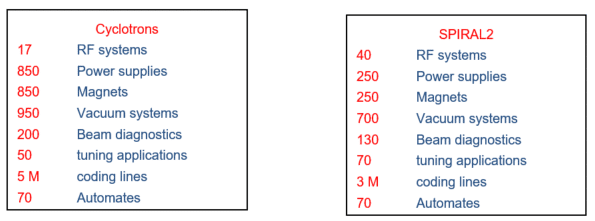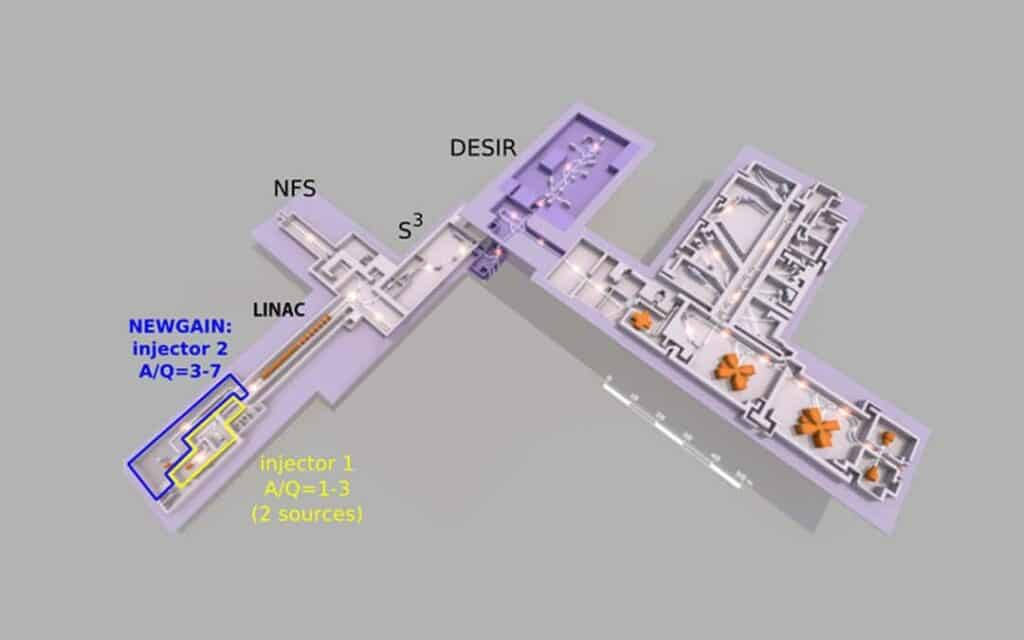- Homepage
- >
- Scientists
- >
- GANIL-SPIRAL 2 facilities
- >
- Accelerators
- Accelerators
- Available beams
- Experimental areas
- ARIBE
- D1
- D2
- D3-D6 / LISE
- D5
- DESIR
- G1 / VAMOS
- G2
- G3
- G4
- IRRSUD
- LIRAT
- NFS – Neutrons for Science
- S3 – Super Separator Spectrometer
- Instrumentation
- ACTAR TPC
- AGATA
- CHATEAU DE CRISTAL
- DIAMANT
- EXOGAM / EXOGAM2
- FAZIA
- INDRA
- LPCTrap
- MORA
- MUST2
- NEDA
- PARIS
- REGLIS3
- S3 Low Energy Branch
- SIRIUS
Accelerators
The cyclotrons complex
The GANIL cyclotrons complex is consisted of five cyclotrons and hundreds meters of beamline. Each year, it delivers more than 4.000 hours of beamtime for nuclear physics and astrophysics, atomic phyisics, material sciences, radiobiology. Several experiments can be ran in parallel. Scientists can choose their beams (type of ion, stable, radioactive, energy, intensity…) and GANIL staff is organized to supply them the chosen beam. Around 100 people work for the development, the running and the maintenance of the accelerators. Five cyclotrons are on site to offer a large range of beam energies :- 2 compact cyclotrons (C01 and C02): Beam energy < 1 MeV/A
- 2 separated sector cyclotrons (CSS1 and CSS2): 13.5 MeV/A < Beam energies < 100 MeV/A
- 1 compact cyclotron SPIRAL1 for radioactive beams: Beam energy < 25 MeV/A
SPIRAL2 Superconducting Linear Accelerator
SPIRAL2 is a new facility which will open new horizons to research at GANIL. The SPIRAL2 LINAC (LINear ACcelerator) can accelerate lighter nuclei (protons, deuterons, helium) than the GANIL cyclotrons, thereby extending the research done until now. The linear accelerator is made of 26 accelerating cavities, enclosed in 19 cryomodules. It is composed of niobium and cooled by liquid helium. It also accelerates heavy ions up to nickel, at intensities 10 times greater than those currently available. This gain in intensity opens up new prospects. Energies ranges :- 33 MeV for protons
- 40 MeV for deuterons
- < 14.5 MeV/A for heavy ions
- up to 5 mA for deuterons
- < 1mA for heavier ions
Beam production
8 ion sources:- 2 ion sources: ECR4 & ECR4M, Q/A ~ 1/9 à 1/3
- ECR type NanoganIII (SPIRAL1)
- Surface ionization (SPIRAL1)
- 1 FEBIAD Source (SPIRAL1)
- 1 ECR ion source, type Phoenix Booster (SPIRAL1)
- 1 ECR GTS Source (R&D)
- Laser Source (R&D)
- 2 sources: ECR Q/A 1/3 and protons/deutons (SPIRAL2)
Key figures

Contacts
- Head of the Accelerator and Engineering division : Gilles Sénécal - gilles.senecal@ganil.fr
- Deputy head: Alain Savalle - alain.savalle@ganil.fr
NEWGAIN


A new injector for worldwide-highest ion beam intensities

The purpose of the NEWGAIN project is to develop a new injector, consisting of an ion source (type: superconductive ECR) and an RFQ (A/q = 7), for the SPIRAL2 LINAG accelerator. It will enable GANIL to provide ion beams of worldwide highest intensities (from proton to uranium), thus opening up unprecedented opportunities for nuclear structure and reaction studies at the extremes of the chart of nuclides from N=Z nuclei at the proton dripline to super-heavy species, including the discovery of new elements, and the production of radioisotopes. It also makes it possible to extend the use of SPIRAL2 beams to interdisciplinary research as well as applications.
A White Book outlining the science requirements guiding the project is available via the following link:
White book – Science Requirements
Project leader: Marie-Hélène MOSCATELLO DI GIACOMO, GANIL
Partner institutions :
- GANIL
- IRFU/DRF/CEA Université Paris-Saclay
- LPSC CNRS/IN2P3 Université Grenoble Alpes
- IP2I Université Claude Bernard Lyon
- IPHC Université de Strasbourg
- CENBG Université de Bordeaux
- IJCLab CNRS/IN2P3 Université Paris-Saclay
- CIMAP IRAMIS/DRF/CEA CNRS/INP&INC ENSICAEN Université Caen Normandie
